Kabob Koobideh (کباب کوبیده) is a favorite Persian dish made from ground lamb or ground beef or a combination of the two. It is typically prepared on skewers and grilled over fire, but you can also make it in the oven, the stove or in an air fryer! Find more of my Persian kabob recipes.

My mother-in-law is a professional when it comes to making Persian Koobideh Kabob, Ground Beef Kabobs. You know, ground meat on a skewer? It sounds easy, but it’s an art form to cook pieces of meat or chicken over an open flame.
If the mixture is off by an ingredient, the whole thing falls off the skewer and into the hot coals. And the kabobs must remain moist and tender, practically melting in your mouth, certainly not like thick, heavy meat patties.
My mother-in-law’s master hands work quickly. She has lovingly and selflessly made these kabobs for her family as long as she can remember: first for her children and her husband, and now for her grandchildren, daughter-in-law and extended family.
My own grandmother was also a master in making koobideh. Although she is gone now, my daii (uncle) carries on the kebab making tradition.
Why this recipe is so awesome
Persian kabob is pretty special. There are many varieties available, from beef to chicken to lamb. Koobideh kabob is made with minced beef (aka ground beef). Sometimes it is a mixture of ground lamb and beef, depending on personal taste.
Koobideh does not have a long list of ingredients, but don’t let that fool you. The flavor is incredible. Like most home cooks, both my mother-in-law and my grandmother do not work in exact measurements. They always measured their food by sight and feel.
When my mother-in-law came over to teach me how to make this kebab, I would run to the measuring spoons and kitchen scale to make sure I everything was accurate.

In it’s simplest form, this koobideh recipe is with ground beef (20% fat), grated onions (drained of excess water), salt and pepper. Sometimes I like to add some chopped parsley, mint and even garlic powder to the mix, but most Persians keep the mixture super simple because that really is all you need.
Traditionally the beef mixture is shaped onto flat skewers and cooked over a fire. But I cook it in the oven, pan fry on the stove and lately, I like to prepare koobideh in the air fryer – less mess!
It isn’t a very complicated recipe. Yes, I use a food processor to mix the ingredients. This creates air and a light not dense kabob. As my MIL told me, “This is not hamburger.”
My readers and I have been making this recipe for 10+ years and it is always a hit. The meat does not fall off the skewers and the flavor and texture is perfect.
Ingredients you need

This post contains some affiliate links for your convenience (which means if you make a purchase after clicking a link I will earn a small commission but it won’t cost you a penny more)! Read my full disclosure policy
- Onions: You will use regular brown onions. One medium onion for every pound of meat.
- Ground beef: Use 85% lean ground beef. This is especially important if you are going to skewer and grill the kabob. If your meat does not have enough fat on it, it will fall off the skewers as it cooks. The extra fat also adds tremendous flavor. You can also use ground lamb or a combination of beef and lamb.
- Salt: Traditionally, Persian koobideh is only seasoned with salt. For additional flavor, you can black pepper, garlic powder and parsley.

Tools to Use
Step-by-step directions
1. Peel and quarter the onions and place in the bowl a food processor fitted with the metal blade and process until puréed and smooth.
My mother-in-law then adds this onion mixture to the blender to purée it even more. I’ve skipped this step because, well, I’m lazy and I have found that this step isn’t necessary and my koobideh still turns out beautifully.
Again, the food processor helps create a light and airy meat mixture and not a dense meat brick.

2. Pour onion purée through a strainer placed over a bowl and drain the juice. If your meat has too much moisture on it, it will fall off the skewers. Reserve the onion juice. Do not discard it!
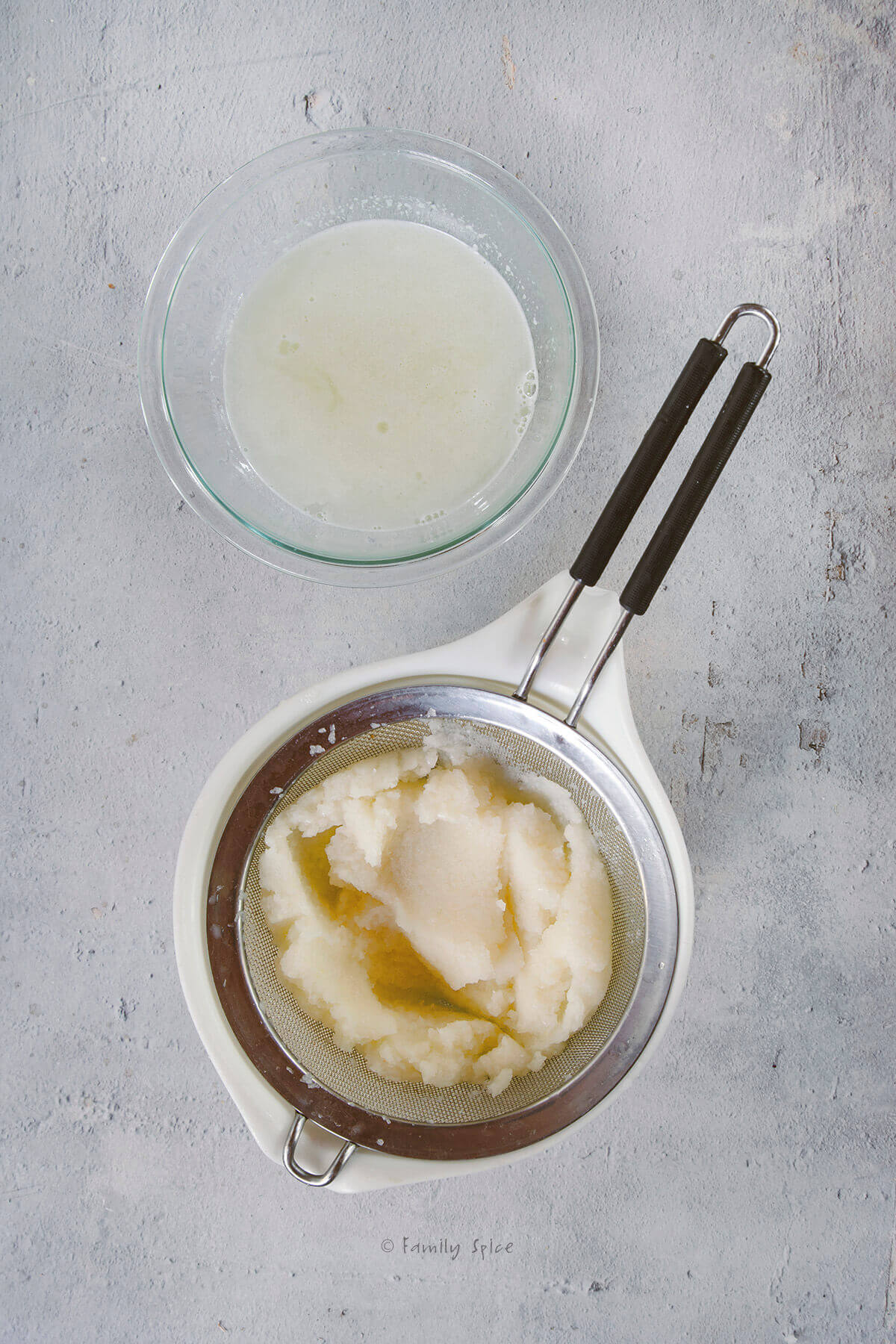
3. Using the food processor again, add alternating layers of ground beef, strained onions and salt. Do not over stuff the food processor bowl. The mixture needs room to move and mix so you might have to break this into batches.
By using a food processor to combine everything, the meat mixture turns out fluffy and the grated onions are blended in perfectly. You can grate the onions and mix everything in a big bowl with your hands. You will need to work it a bit longer than you think because, again, this is not a hamburger you are preparing.

4. Process until combined, pausing to scrape down the sides. The mixture will get fluffy and light in color. Transfer mixture into a large mixing bowl. If you have more meat and onions to mix, continue doing this.

5. Once all of the kabob mix is processed and transferred, begin kneading it like bread dough, dipping your hands into the onion water to keep the meat from sticking to your fingers.
The more you knead the kabob mix, the lighter the kabob. Texture should be airy and fluffy, and not a heavy, dense mass like in a hamburger. Kabob mix shouldn’t be sticking to your hands especially with them wet with onion water. This should take about 20 minutes.
Allow kabob to marinate in a refrigerator in a covered bowl for 2-4 hours.

6. Now comes the fun part. You will form the meat patties onto flat metal skewers. Do not use thin bamboo skewers otherwise your kabab koobideh will spin around on a thin skewer.
Start with a softball size amount of koobideh mix and pierce it down to the center of your skewer.

7. Once your softball of koobideh is in the center of your skewer, use one hand to squeeze it and massage it onto the skewer. The center of the skewer will be filled with the koobideh mix.
You need to leave several inches off the ends of the skewers open so it can sit properly on your grill. Knowing how big your grill opening is also decides how long you can make your koobideh kabob.
Your koobideh mix should wrap around the skewer, but not be bulky. So for the engineers out there who need exact measurements, we are talking about a half an inch of meat on the top and a half an inch of meat along the bottom of the skewer.
Using two fingers to mimic scissors (the forefinger and index finger), “scissor” the meat down the skewer to make the bumps you normally see in koobideh kabob.
The ends of the koobideh mix should not be open. Use your fingers to pinch the ends, sealing it shut to the skewer. All the while as you work, dip your hands in the reserved onion juice or regular water to keep the meat from sticking to your hand.

8. Grilling Persian kabob is all about getting down to the basics. You do not need a fancy grill. In fact, I have memories of my grandmother sitting on her haunches fanning the flames of her little hibachi-style charcoal grill.
You can rig a gas grill by removing the grate and placing some metal stands so the skewers of meat sit above the open flame. We have also used these big stainless steel chaffing pans to be a cheap and efficient way to grill koobideh kebab – or any kabob, for that matter.
You can also cook your koobideh kabob in one of these kabob grills that are specifically designed to lay skewers of meat over hot coals – without crouching or bending over.
To grill the kebab, prepare your coals. You know your grill is ready when you hold your hand over the grill for 3 seconds and your hand feel too hot to remain there. The coals should be gray and covered with ash.

While the kebab cooks, grease will fall and you will have flashes of fire so be prepared for that. As they cook, turn the skewers every minute so the kebab cooks evenly. If you wait too long and cook one side too much before turning the skewer, your kabob will fall off the skewer.
Depending on how hot your fire is, it can take up to 15-20 minutes to cook. If your fire is very hot, it will cook faster, you will have to stay on top of turning the skewers and the edges could get crispy.
As kabobs are done, remove from grill and remove meat from skewers by grabbing it with a sheet of lavash bread and sliding it down the skewer. Place the kabob on a serving dish and cover with another sheet of lavash to keep the meat warm.
Recipes tips and FAQs
Traditionally kebab is served served with basmati rice and a platter of fresh herbs, or sabzi khordan. Many Persians like to add a raw egg yolk in the middle of the rice. You mix the yolk in with the rice for a creamier texture.
We love to eat our kabob with either mast o khiar (Persian yogurt with cucumbers) or Shirazi salad. My husband especially loves kabob with homemade torshi (pickled vegetables).
This can also be made with a mixture of beef and lamb. But for practicality purposes, we primarily use ground beef. Again, low-fat (10% fat or less) ground meat is not recommended for this technique. You need the fat for flavor and to help the meat stick to the skewer.

Although koobideh is not a hamburger, the mix certainly makes a great burger! When we are not in the mood to deal with the skewers, we make koobideh burgers! This mixture really makes an awesome Persian kabab burger!
And one last kabob fusion food inspired by our favorite kabab. We make this koobideh kabab ground beef jerky ALL THE TIME. My kids love jerky and it makes a delicious (and super easy) protein rich snack for the whole family.
If you are a camper or backpacker, the ground beef jerky makes a fabulous backpacking meal.
Koobideh in the oven
You can cook koobideh in the oven, when you do not have a grill. My American dad has perfected this technique and cooks koobideh this way all the time. You do not need skewers if you cooking your kabob in the oven. You will need a broiler pans like this one to place the kabob on.
Form the meat into elongated fat hot dog shaped kabobs, about 1-inch thick and 6-inches long. Place each kabob on the top pan.
You want to use both pans, so that the drippings will fall below the kabob. Leave at least 1-inch between each kabob. You don’t want to over crowd the pan.
Heat the oven on broil for at least 10 minutes so your oven is piping hot. You also want the oven rack to be place on the top level. Once your oven is hot, place your pan full of koobideh kabob in the oven and cook for about 10 minutes, then turn kabob over and continue cooking for 10 more minutes or until juices run clear.
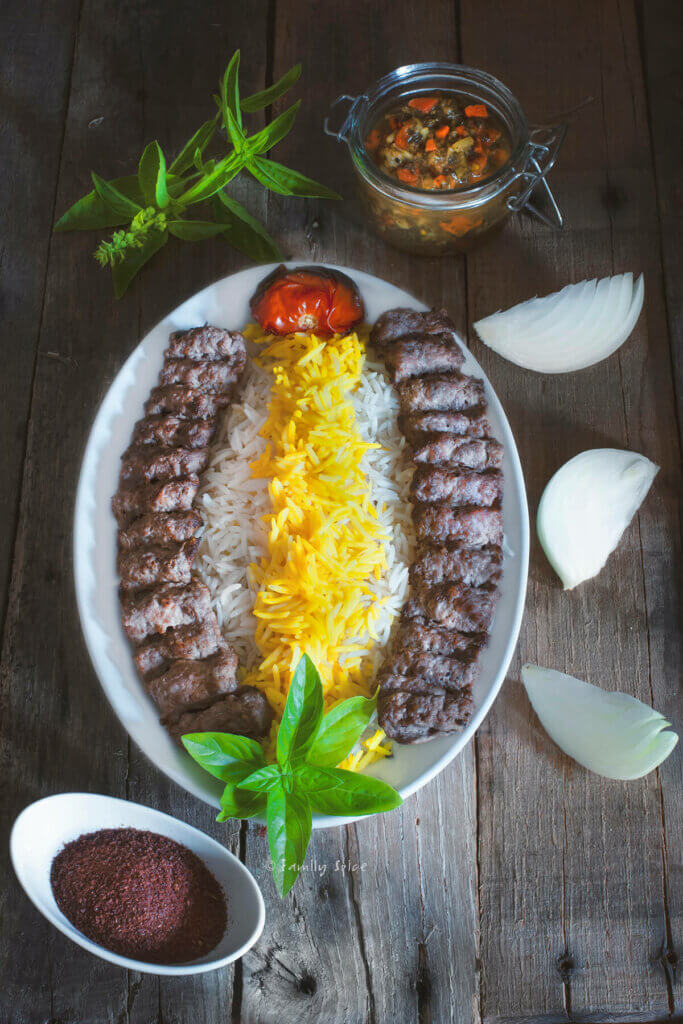
Koobideh in the pan
You can also prepare koobideh kabob in a pan on the stove. This version is called kabobi deeg, or kabob from a pot. I mix the koobideh as I would for skewering, form the kabobs like you do for the oven, but smaller, maybe 4-inches long.
Then heat a pan, add some olive oil or melt some butter and brown your kabob on every side until done. Easy peasy, kabob in a flash!
And finally, you can also prepare kabob koobideh in the air fryer! So many ways to enjoy this delicious meal!
Koobideh Kabob (کباب کوبیده) is a favorite Persian dish made from ground lamb or ground beef or a combination of the two. It is typically prepared on skewers and grilled over fire, but you can also make it in the oven, the stove or in an air fryer!
Chelo kabab (chelow kabob or chelo kebab), is farsi for white rice with kebab. Most of the time, the meat kabob in this recipe is called koobideh (kubideh), which is ground beef (or ground lamb) kabob.
Koobideh kebab is made with ground meat. It is more commonly made with ground beef, but can also be made with ground lamb or a combination of the two. A growing popular dish is chicken koobideh which is made with ground chicken.
Kabob Koobideh (Persian Ground Beef Kabob)

Kabob Koobideh (کباب کوبیده) is a favorite Persian dish made from ground lamb or ground beef or a combination of the two. It is typically prepared on skewers and grilled over fire, but you can also make it in the oven, the stove or in an air fryer!
Ingredients
- 2 medium-sized onions
- 2 teaspoon salt
- 2 lb 85% lean ground beef
- 2 lavash bread
Instructions
- Grate onions using a food processor.
- Place the onion mixture into a blender and puree until smooth, about 2 minutes.*
- Place the onion mixture in a strainer over a bowl and drain the juice. Kabob will not hold its shape if mixture has too much water. Reserve the onion juice.
- Using the food processor again, but with the chopping blade, place meat and salt in alternating layers with the onion mixture.
- Add onion juice little by little if mixture is dry. Meat-onion mix should have elasticity and stretch to it.
- Put kabob mix into big bowl and knead like dough. The more you knead the kabob mix, the lighter the kabob. Texture should be airy, not a solid mass like in a hamburger. Kabob mix shouldn't be sticking to your hands.
- Allow kabob to marinate in a refrigerator in a covered bowl for 2-4 hours.
- Remove kabob mixture from the refrigerator and start your charcoal at least 30 minutes prior to grilling.
- The amount of meat you use, depends on the size of skewers you have. Long flat skewers work best with ground beef kabob as it holds the meat better than a thin round skewer. For our skewers we started with a baseball-size ball of kabob mix.
- Gently pierce the meat patty with your skewer and slide it down to the middle of the skewer. Use reserved onion juice or water to keep your hands moist and to keep them from sticking to the meat.
- Softly squeeze the meat flat as you position the meat onto the skewer. Make sure you leave room on either ends of the skewer as it rests over your grill.
- Using two fingers to mimic scissors, pinch both ends of the kabob meat, cutting off any excess.
- Also using two fingers softly squeeze down the skewer leaving ridges.
- Place skewers on the grill. The meat should not touch any grill plates. Instead the skewers should be propped up over your coals or flame. You know your grill is ready when you hold your hand over the grill for 3 seconds and your hand feel too hot to remain there.
- Cook until done, approximately 15-20 minutes, turning the skewers every minute to evenly cook. If you wait too long and cook one side too much before turning the skewer, your kabob will fall off the skewer.
- As kabobs are done, remove from grill and remove meat from skewers by grabbing it with a sheet of lavash bread and sliding it down the skewer.
- Place the kabob on a serving dish and cover with another sheet of lavash to keep the meat warm.
Notes
Serving Suggestions: Serve with basmati rice or lavash bread. Other side dishes include mast o khiar (Persian yogurt with cucumbers), Shirazi salad, homemade torshi (pickled vegetables), a platter of fresh herbs, or sabzi khordan. Many Persians like to add a raw egg yolk in the middle of the rice. You mix the yolk in with the rice for a creamier texture.
This can also be made with a mixture of beef and lamb. But for practicality purposes, we primarily use ground beef.
Cooking Tips: The ingredients are simple, but the technique is key. You want the meat mixture to be sticky enough to stay on the skewers and not fall off during the grilling process. Long flat skewers work best with this kabob.
To cook in the oven, form kabob mix into desired shape and place onto a broiler pan coated with non-stick spray. Broil in the oven on the top-most shelf until kabob starts to brown, about 5-7 mins. Turn kabob over & broil for 5 more mins or until cooked through.
* This step can be skipped. The secret to great ground beef kabob is to make sure your onions are pureed very smoothly. You don't want to taste the onion pieces, as you would in a hamburger. The texture is very different.
Nutrition Information:
Yield:
6Serving Size:
5 ozAmount Per Serving: Calories: 455Total Fat: 23gSaturated Fat: 9.3gCholesterol: 133mgSodium: 983mgCarbohydrates: 16.8gFiber: 1.4gSugar: 1.8gProtein: 41.3g
PS If you try this recipe, why not leave a star rating in the recipe card right below and/or a review in the comment section further down the page? I always appreciate your feedback.
You can also follow me on Pinterest, Facebook or Instagram. Sign up for my eMail list, too!
This post has been updated. It was first published January 8th, 2009.

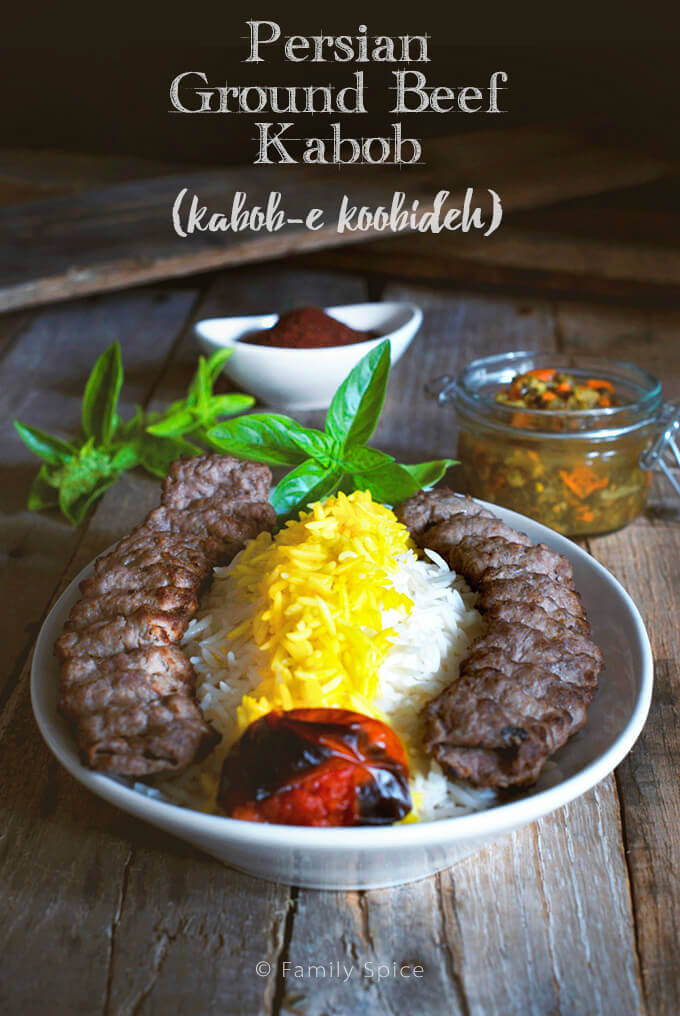





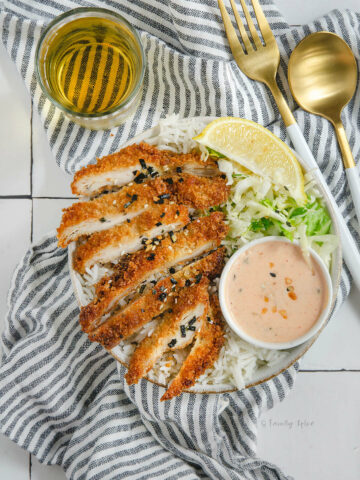

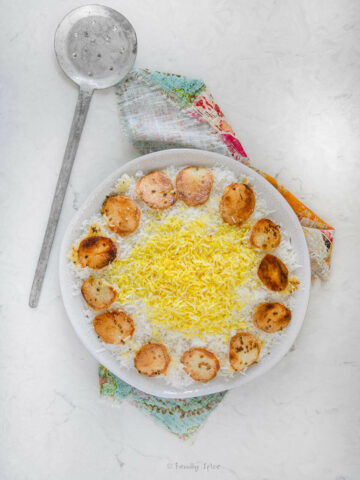

In the oven, should it be cooked for 10 min on both sides (in the long description with the rest of the necessary details for using the oven), or 5-7 min one side and 5 min on other (in the shortened recipe)?
there’s no such thing as a brown onion… what was used in this recipe is a white onion
Hi Bob-
Just google ‘brown onion’ and you will see that they do exist. They are also called yellow onions. These are the onions with the brown paper like peel around them. White onions have white paper like peels around them.
Laura
How do restaurants stretch the koobideh? Do they use potatoes or bread crumbs.
Hi Tami,
There are no potatoes or breadcrumbs added to koobideh at home or at restaurants. The way the beef is mixed makes it elastic. We do not stretch it on the skewers, but press it and flatten it onto the skewers.
Laura
This is a wonderful article! Koobideh kebabs were a food of my youth I miss dearly.
Shahbaz-
Koobideh has a special place in our hearts, too.
Laura
Why no other flavor? just salt? This can’t be good.
Jenny-
Traditional koobideh kabob has only meat, onions and salt. It’s actually quite delicious. Don’t knock it ’til you try it.
Laura
Wow! I wish I was there to try it. Sounds fantastic. (What beautiful hands she has!)
Which way do you lay the kebabs on the broiler pan vertical or horizontal? Do you lay them beside or across the holes of the pam
What temperature do you.put the broiler on? You have to select a temperature on mine .theres no high low option .would 400 f be to low?
I believe the broiler temperature is more like 500ºF (260ºC).
What if the broiler only is high or low where you can’t set the temperature. Im assuming high is fine?
Thank you for all of this wonderful information! I am so excited to try this! I just want to confirm you use 20/80 fat/meat not 15/85? You mentioned in the description to only use 20%, but your ingredient list says 15%. Thank you for your help!
If you are using skewers and you don’t want the meat to fall off, 80/20 works best. I have gotten away with 85/15, but 80/20 is safer.
Laura
So many useful tips for making the best beef kabobs! Thank you for sharing your mother-in-law’s amazing recipe.
My mother-in-law was happy that someone wanted to learn her cooking secrets!
This is a great post! I love the simplicity of this recipe!
Thank you! Simple AND delicious!
Hi, I’ve read that you mix the grated and strained onions to the ground beef and then finally mix them up in the food processor? Is that correct? Thanks
Hi Arash-
Sorry for not writing sooner. I have been sick in bed for the last week. Yes, you read the post correctly. Just make sure you separate the grated onions from its juices before mixing it with the meat again. Save the onion juice for later when you are ready to massage the meat onto the kabob.
What a great post. The pictures of leaning down and cooking on the grill outside remind me of pictures of Doug’s Korean grandma doing the same on the beach in Hawaii cooking kalbi. These are a bit like latkes – very few ingredients but so much technique! Thanks for sharing!
My grandmother didn’t mind cooking for 30 people using that little grill! Go bless grandmothers!
Dang, Laura, these sound wonderful! And thank you for teaching me about the flat skewers. That changes everything in kabob land! Also, I love that you are passing this family recipe forward within your own family while also sharing it with all of us. xo
Flat skewers are life changing when it comes to kabob-making! Happy to help! xoxox
Perfect recipe! Thank you for sharing!
You’re very welcome!
I absolutely LOVE this recipe. But I scares me to death making them because of how easy they fall off of the skewer. I think the closer the meat comes to room temperature, the more likely they are going to fall off, no matter how evenly you rotate them. I use a yogurt strainer to strain my onion puree and reserve the juice in case I need it. The juice is great to freeze and add to soups later.
It is always a challenge to keep the meat from falling off the skewers. If you have a refrigerator big enough to hold the skewered meat, then yes, keep it cold. Here in San Diego, our nights are cool so we are able to keep it cool sitting out on the table. The onion juice is definitely a secret flavor weapon. Great idea on freezing it!
hello sir
i’m mohammad from iran and i know english a little !
Put the meat and onion mixture in the refrigerator for 3 hours before cooking
Yes, this lets the meat flavors meld together and helps it stay on the skewer.
Thank you for a wonderfully informative lesson. The ingredients are so simple but I fear the method will take some time: have never made a mixture this way and have always been taught mince should be handled as little as possible 🙂 ! Very interesting and shall soon try to see whether I can get it right!! Have the right skewers . . . oh, and love the family photos . . . enjoyable post . . .
Eha, until my mother-in-law showed me how to do it, I wasn’t very successful making kabob either. The food processor may become a mess to cleanup afterwards, but it fluffs the meat beautifully and my kabob never fall off the skewers. Let me know how it works for you!
Sent this to some friends and quite a few wrote back to say they would subscribe . . . yes, shall tell you when I get a reasonable result 🙂 !
This is always my favorite meal at your place. Watching your husband grill the meat skewers over his make shift grill is half the fun. The other half is listening to his stories of growing up in Iran.
And I believe, you were just invited for another night of kabob at our house!
Really? We’re so making that happen! We love sharing food, fun and family with you all.